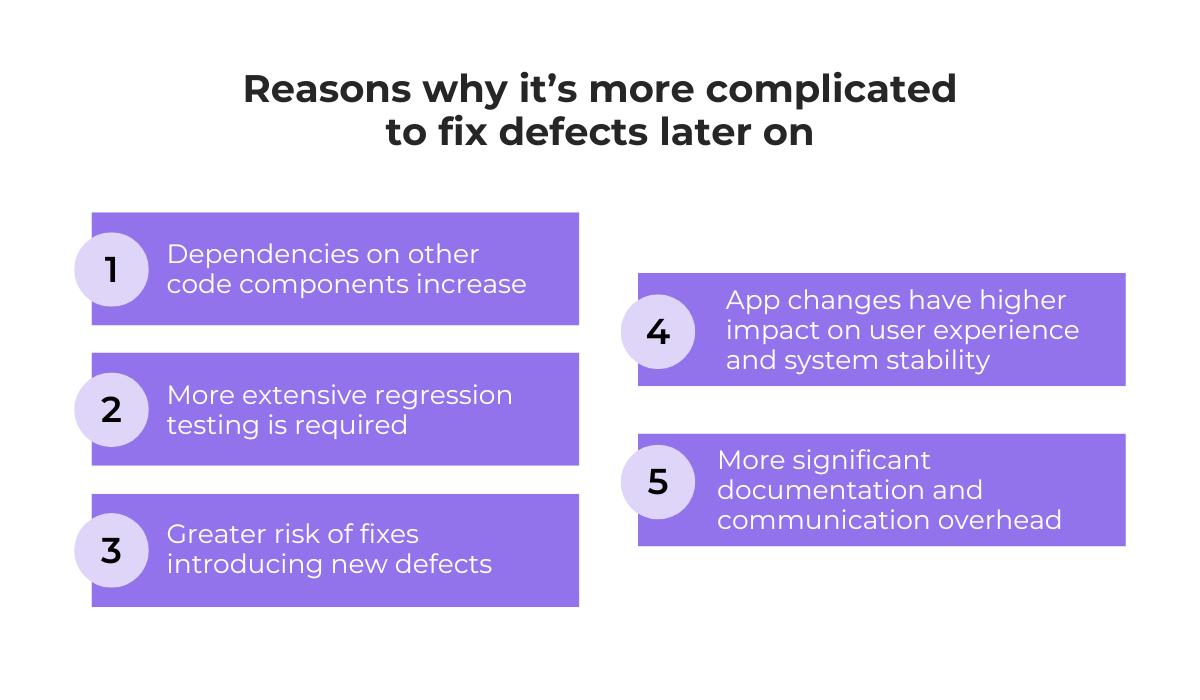
A well-oiled defect management process can make all the difference between a smooth project and a chaotic and issue-ridden one.
But, like any process or tool, defect management has its pros and cons.
So, knowing its strengths and weaknesses will help you use it wisely and avoid potential pitfalls.
If you’re curious about how defect management can improve the quality of your software and make your team more efficient, but also wondering what challenges might lie ahead, stick around.
In this article, we’ll take a look at the good and the not-so-good so you can make informed decisions about incorporating defect management into your development process.
Let’s begin.
Table of Contents
Advantages of defect management
Defect management plays a huge role in the success of software development projects, helping identify, track, and resolve issues.
Knowing some of the specific advantages is crucial to empower teams to make the most out of this process.
So, let’s explore three key benefits: early defect resolution, cost reduction, and enhanced user satisfaction.
Each of these advantages is fundamental to delivering reliable and high-performing software.

Get unreal data to fix real issues in your app & web.
Early defect resolution
One of the standout benefits of effective defect management is its ability to facilitate early defect resolution.
This means identifying and addressing issues as early in the development lifecycle as possible.
This can minimize their impact and reduce the amount of resources needed to resolve them.
The effort required to fix defects can vary significantly depending on the stage of the software development lifecycle (SDLC) in which they’re discovered, as shown in the table below.
| SDLC Stage | Effort to Resolve Defect |
| Requirements & Design | Minimal effort; changes involve updating documentation and plans. |
| Development | Moderate effort; requires code modifications and possible rework. |
| Testing | Significant effort; defects require bug fixing and regression testing. |
| Release | Maximum effort; can involve hotfixes, patches, and extensive rework. |
Notice how the effort skyrockets as you move closer to release.
This underscores the importance of implementing proactive defect management practices early in the process.
When left to fester, unresolved defects can quickly become entangled with other aspects of your software, making them more difficult to fix.
Take a look at some of the reasons for these complications below.

As an example, code dependencies might be introduced as features are built upon potentially flawed foundations.
Additionally, attempts to fix a late-stage defect can introduce new, unforeseen issues.
This ultimately creates a domino effect of problems for end-users and disrupts their experience with hotfixes.
To maximize the advantage of early defect resolution, many organizations integrate defect testing as early as possible in the SDLC.
An Applause survey of 946 organizations reveals some interesting insights, such as the fact that over 85% of organizations tend to test features as they’re being developed.

The reasoning behind this trend is clear: catching issues early allows for faster, simpler fixes.
It minimizes the ripple effect of changes, reduces the risk of introducing new problems, and keeps your development on schedule.
So, by addressing issues as soon as they arise, defect management helps build a more robust and reliable product.
Cost reduction
Closely related to the advantage of early defect resolution is the significant reduction in costs.
Cost-related issues are a major problem for IT projects, often leading to budget overruns and delayed benefits.
In fact, McKinsey research reveals that the majority of projects fail to deliver their expected benefits on time and within budget.

This means that inefficiencies and unforeseen complications frequently derail project plans, resulting in increased expenses and resource wastage.
Naturally, defects play a major role in these cost issues, contributing to the complexity and expense of managing software projects effectively.
As Kent Beck, author of Extreme Programming Explained: Embrace Change, points out in his book, defects carry substantial costs.

It should come as no surprise that a more complex problem costs more to fix and, in our case, the resources required to fix a defect after release are significantly higher compared to addressing it during coding.
Take a look at how this cost difference can look like when presented visually.

Defect management practices address this issue by shifting the focus to early detection and resolution, preventing issues from appearing altogether or from escalating in complexity.
Additionally, defect management ensures that issues are prioritized and addressed based on their impact and effect on the app or business objectives through defect triage.
This practice ensures that the most problematic defects, which would otherwise be the most expensive to fix later on, receive the necessary attention and resources upfront.
What this means is that, by incorporating robust defect management practices, organizations can significantly reduce the financial burden associated with software defects, leading to more efficient use of resources.
Enhanced user satisfaction
Finally, a major advantage of defect management is that it significantly boosts user satisfaction.
After all, no one wants to use a buggy application that crashes frequently or behaves unpredictably.
Users expect a smooth and seamless experience, and defect management helps meet these expectations by increasing the quality and reliability of your software.

The most direct benefit is that it results in fewer defects in the application, leading to a higher quality product.
Simply put, users encounter fewer bugs, which translates to a more reliable and enjoyable experience.
Additionally, defect management improves the user experience by fixing parts of the app that may not be performing optimally.
This is essential, as over one-third of users report leaving a brand due to a poor experience.

For instance, users might abandon an app if they encounter slow performance, unexpected crashes, or errors in critical functions.
Proper defect management addresses these issues before they escalate, maintaining a positive user experience and protecting your brand’s reputation.
Effective defect management remains important even after the product release, as it ensures the application stays stable, preventing crashes or outages.
This aspect becomes increasingly critical as the user base and product grow.
A notable example is Facebook’s (now Meta’s) outage in March 2019.

The outage, which lasted around 14 hours, was significant enough to cause a 2% drop in their stock price.
This example perfectly showcases the negative consequences of a relatively short disruption and the importance of maintaining stable operations.
Robust defect management practices can help prevent such disruptions by continuously identifying and resolving issues before they can develop into significant problems.
Ultimately, effective defect management enhances the technical quality of your software and ensures a better experience for users.

Limitations of defect management
While defect management offers substantial benefits, it also comes with its own set of challenges.
In the following sections, we will explore three key limitations: the resource-intensiveness of the process, potential resistance to change, and the challenge of balancing defect resolution with feature development.
Pay close attention, as recognizing and addressing these limitations will help ensure that defect management practices are effectively integrated into your development process.
Resource-intensiveness of the process
While defect management helps save resources in the long run by preventing costly issues from escalating, it is itself a resource-intensive process.
Setting up an effective defect management system can be complex and requires significant effort from both development and quality assurance teams.
This effort includes designing processes, setting up tools, and ensuring that all team members are properly trained.
Excessive manual testing is often a major contributor to this resource burden.
This challenge can be mitigated by implementing automated testing, which reduces the need for repetitive manual checks.
Take a look at the scenario below, illustrating how automated regression testing is less resource-intensive.

Although automated testing requires an initial investment in terms of setup and configuration, it becomes increasingly less resource-heavy as time progresses, helping perform repetitive tests consistently, and freeing up the team to focus on more complex tasks.
Another factor that helps reduce resource consumption in defect management is using an issue tracking system like Jira.

Issue tracking software helps lower resource consumption by centralizing and organizing defects, streamlining the tracking process, and providing visibility into defect status and history.
This centralization reduces the time spent on manual tracking and communication, making it easier for teams to manage defects effectively.
Coupling an issue tracker with a bug and crash reporting system like Shake can further reduce the manual workload.

With Shake, users and testers can automatically create reports with over 70 different metrics of data attached, significantly easing the manual process of writing reports and tracking defects.
In summary, while defect management can be resource-intensive initially, utilizing automated testing and robust issue tracking tools can greatly reduce the ongoing effort required, making the process more efficient over time.
Potential resistance to change
While investing resources in defect management is crucial, its success ultimately depends on adoption by your organization.
Teams may resist adopting new defect management processes or tools, especially if they are accustomed to existing practices—even if those practices are inefficient.
The reasons for resisting change are numerous, but we have singled out a few in the illustration below.

It’s natural to mistrust a change or fear that you will fail when using a new process or technique.
This anxiety can be heightened if team leads and managers do not offer adequate help and training, or if they expect the new method to be mastered instantly.
This approach can lead to frustration and decreased morale among team members.
Therefore, it’s essential to introduce any new defect management practices and tools gradually, along with proper guidance and support.
The Kübler-Ross change curve, which describes how individuals typically respond to significant changes, can help you understand a common reaction to change that you may face with team members.
A modified version of this pattern, tailored to organizational change, is shown in the image below.

As shown, teams often experience shock and frustration with any new processes, which can eventually lead to diminished morale if they do not receive the necessary support.
However, if there is clear communication about defect management and its benefits, and if team members are involved in the decision-making process, their initial resistance can transform into curiosity and experimentation with the new approach.
Over time, they may decide to learn how to work within the new framework and eventually integrate the defect management process into their routine.
So, proper communication, training, and gradual implementation can help teams adapt to defect management more smoothly.

Very handy for handling user feedback. CTOs, devs, testers – rejoice.
Balance between fixing defects and feature development
Finally, while focusing on defects and defect management is crucial, it’s important to remember that an app also needs to evolve in terms of features.
Balancing the act of fixing defects with continuing feature development can be challenging, especially under tight deadlines.
This challenge arises because both activities compete for the same limited resources—time and manpower—and prioritizing one over the other can impact overall project goals.
To overcome this hurdle, it’s essential to prioritize both defect fixes and feature requests based on their impact and the effort required to address them.
This means assessing how critical a defect or a new feature is to the user experience or business objectives, and how much time and resources are needed to implement the fix or develop the feature.

For instance, a defect that requires low effort to fix, but has a high impact on user satisfaction should be prioritized.
An example could be a minor bug causing a significant user inconvenience, such as a non-functional “submit” button on a critical form.
On the other hand, a feature requiring significant effort but promising a large impact, like a major new module or integration, might be reserved for a later project phase where adequate resources are available.
There are two differing viewpoints when it comes to balancing defect fixes and feature development.
On one side, we have Microsoft’s “zero defects” methodology, which aims to clear almost all defects before introducing new features on top of a product.

This approach is commendable for its focus on stability and reliability.
However, it is not always practical or achievable, especially in dynamic development environments where continuous delivery and iterative updates are expected.
Moreover, as Ben Miller explains in his Quora answer, company objectives and priorities should ultimately guide the decision between defect fixing and feature development.

Miller suggests that, if adding a new feature aligns more closely with business objectives and provides significant value to users, it might take precedence over minor defects.
Conversely, if defects are severely impacting user satisfaction or system stability, they should be addressed promptly, even if this delays new feature development.
We recommend adopting a balanced approach that considers both perspectives.
This involves continuously evaluating the impact and effort associated with defects and features, aligning them with business objectives, and making informed decisions about resource allocation.
Conclusion
So, there you have it—the good, the bad, and the reality of defect management.
We discussed how defect management aids in early defect resolution, reduces costs, and enhances user satisfaction, while also acknowledging challenges like resource intensiveness and resistance to change.
Hopefully, this guide has provided you with a clearer understanding of defect management and why it’s important to be aware of its challenges.
You can use some of these insights to better understand and streamline this process, while also finding ways to mitigate its limitations and improve project outcomes.
To conclude, effective defect management is key to delivering reliable software, and you’re now better equipped to implement it successfully.






